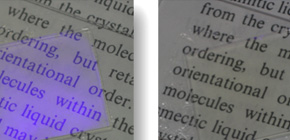
Light freely bends and expands on a flat reflector
New technology applicable to reflective optical devices such as smart glasses
Cholesteric liquid crystal is a material in which rod-like molecules form a helical structure and Bragg reflects circularly polarized light in the same direction as the helix which has a special frequency due to its helical structure.
Using these properties, applications to circularly polarized light devices and electronic paper have been examined; however, cholesteric liquid crystal produces only specular reflection with the same angle of incidence and angle of reflection, so its viewing angle characteristics were poor, presenting limited performance.
A group of researchers led by Assistant Professor YOSHIDA Hiroyuki, Graduate Student KOBASHI Junji, and Professor OZAKI Masanori (Graduate School of Engineering, Osaka University) found that the optical phrase reflected from cholesteric liquid crystal changed depending on the helical phase, developing a technology for freely controlling reflection wavefronts from cholesteric liquid crystal in which rod-like molecules autonomously form helical structures. Through this, cholesteric liquid crystal, which previously could only be used as flat mirrors, can now serve as lenses and deviate reflected light.
In addition, since cholesteric crystals retain their ability to selectively reflect only circular light, it has become possible to realize unique optical devices capable of deviating or collecting light while reflecting specific circular light.
This material will be used for high-performance and inexpensive catoptrics devices such as thin optical isolators capable of blocking light and return mirrors for smart glasses which are now spreading as wearable devices.
Abstract
Reflective metasurfaces based on metallic and dielectric nanoscatterers have attracted interest owing to their ability to control the phase of light. However, because such nanoscatterers require subwavelength features, the fabrication of elements that operate in the visible range is challenging. Here, we show that chiral liquid crystals with a self-organized helical structure enable metasurface-like, non-specular reflection in the visible region. The phase of light that is Bragg-reflected off the helical structure can be controlled over 0–2π depending on the spatial phase of the helical structure; thus planar elements with arbitrary reflected wavefronts can be created via orientation control. The circular polarization selectivity and external field tunability of Bragg reflection open a wide variety of potential applications for this family of functional devices, from optical isolators to wearable displays.
.png/@@images/image)
Figure 1. Schematic illustration (left) and photos (right) of a standard cholesteric liquid crystal device. The green bars in the left figure are guides indicating positions with the same helix phase. Cholesteric liquid crystals reflect circularly polarized light with the same handedness as the helical structure and with wavelength fulfilling the Bragg condition (refractive index × helical pitch). In the right figure, purple light with right circular polarization is reflected.
.png/@@images/image)
Figure 2. Schematic illustration of a cholesteric liquid crystal device with lens functionality (left) and photos of reflected beam spots (right). The parabolic profile of the helix phase converts the incident plane wave to a converging beam, which focuses to a spot.
To learn more about this research, please view the full research report entitled " Planar Optics with Patterned Chiral Liquid Crystals " at this page of the Nature Photonics website.
Related links
